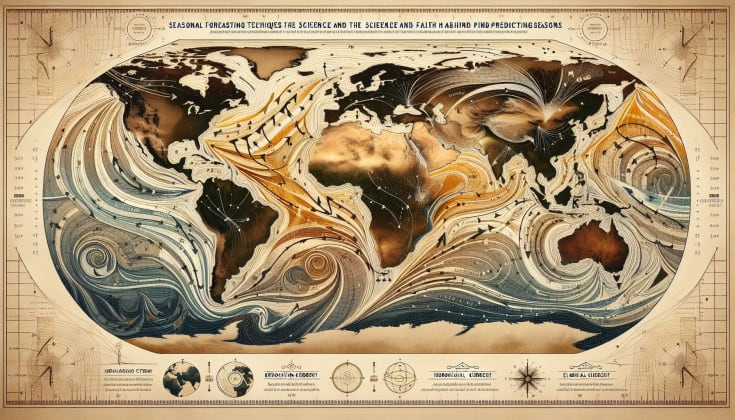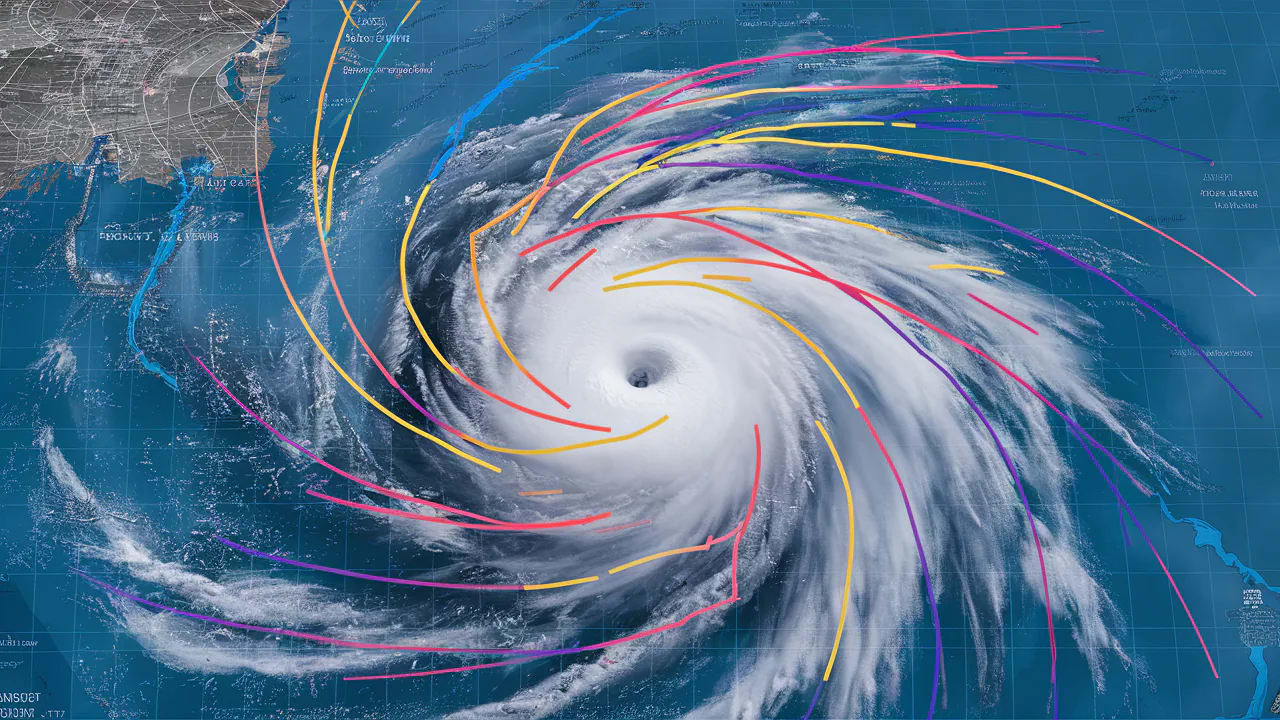Seasonal Forecasting Techniques: A Deep Dive into the Science and Faith Behind Predicting Seasons
Discover comprehensive techniques used in seasonal weather forecasting through a Christian lens, uncovering the science, accuracy, and the role of faith.
Seasonal weather forecasting remains one of the most controversial topics in meteorology. Why? Because despite our incredible advancements, we often find ourselves at nature’s mercy, swinging between accuracy and unpredictability. Data shows that even the most sophisticated models only achieve about 60-70% accuracy (National Weather Service, 2023). This blog post will shake down the core techniques of seasonal forecasting, address your struggles with forecasting woes, and tie in both a scientific and Christian perspective to show how we can place our trust in God’s design.
Many of you visit Optic Weather to find reliable seasonal forecasts for planning purposes, whether it be for agriculture, travel, or simply staying prepared. I get it—pinning down the perfect forecast is essential but challenging! Let me walk you through the various techniques meteorologists use, share some of my personal experiences, and offer a Christian outlook to give context to these phenomena.
The ultimate goal here is to help you understand the mechanisms behind seasonal forecasts and show how they fit into the grand scheme of God’s creation.
Feel free to jump to sections that most interest you:
- Understanding Seasonal Forecasting
- El Niño and La Niña: The backdrop Predictors
- The Role of Ocean Currents
- The Influence of Atmospheric Pressure
- Advanced Techniques in Seasonal Forecasting
- Biblical Parallels in Weather Prediction
- The Reliability of Seasonal Forecasts
- Case Studies and Real-World Examples
- Forecasting in the Age of ecosystem Change
- Tools and Resources for Better Forecasting
- Embracing the Unpredictable with Faith
- Key Takeaways and Practical Tips
Seasonal forecasting involves predicting the average conditions over weeks to months, typically focusing on temperature and precipitation. These predictions are notoriously difficult due to the variability in elements like ocean currents, atmospheric pressure, and even solar cycles.
Why is it challenging?
- Complex Interactions: Interconnected elements like ocean currents, atmospheric conditions, and land surface temperatures interact in complex ways.
- Data Scarcity: Reliable historical data is often scarce, specifically for remote regions.
Despite these challenges, modern technology has significantly improved our capabilities. The primary techniques include:
- Dynamic Models: These use physical equations to simulate weather patterns.
- Statistical Models: These rely on historical data to predict future trends.
- Hybrid Models: Combine dynamic and statistical approaches for more accuracy.
Quotable Fact:
“Seasonal forecasting can achieve a predictive accuracy of around 60-70%, depending on the region and the element being forecasted.” - National Weather Service, 2023
El Niño and La Niña are phenomena that result from unusual warming or cooling of the Pacific Ocean. These conditions can significantly impact seasonal weather patterns globally.
How They Work
- El Niño: Characterized by unusually warm ocean temperatures in the Equatorial Pacific.
- La Niña: Characterized by unusually cool ocean temperatures in the Equatorial Pacific.
Impact:
- Global Weather Patterns: These phenomena can influence rainy seasons, droughts, and even impact hurricane forms across the globe.
- Predictive Value: By recognizing these patterns early, meteorologists can offer more accurate seasonal forecasts.
Key Data Points
- According to NOAA, “El Niño tends to cause warmer, drier winters in the northern U.S., while La Niña leads to cooler, wetter conditions.”
- Over the past 50 years, the predictive success rate using these phenomena has increased by about 20%.
Biblical Insight:
“The wind blows wherever it pleases. You hear its sound, but you cannot tell where it comes from or where it is going.” - John 3:8
Trust in God’s rhythm is as crucial as technological advancements. We interpret His creation, but His grand plan surpasses our understanding.
The Role of Ocean Currents
Ocean currents—large scale water movements across the oceans—play a vital role in seasonal weather patterns. These currents are influenced by factors like wind, salinity, and temperature.
Types of Ocean Currents
- Surface Currents: Primarily driven by wind patterns.
- Deep Water Currents: Driven by differences in water density.
How Do They Affect Weather?
- Heat Distribution: Currents redistribute heat around the globe, influencing coastal and inland weather.
- Marine Life: They also impact marine ecosystems, which indirectly affect weather patterns.
Expert Insight:
“Approximately 80% of seasonal milieu variations are influenced by ocean currents.” - American Meteorological Society, 2022
This science of understanding can be pivotal in recognizing how interconnected our world is—a true testament to God’s intricate design.
Interesting Facts:
- Gulf Stream: A major ocean current that significantly affects weather patterns on the East Coast of the United States and Europe.
- El Niño’s Impact: Can disrupt normal ocean currents, altering weather patterns significantly.
The Influence of Atmospheric Pressure
Atmospheric pressure significantly affects weather and can be a predictor for seasonal changes.
Types of Pressure Systems
- High-Pressure Systems: Generally bring clear skies and stable weather.
- Low-Pressure Systems: Often result in clouds, precipitation, and storms.
Seasonal Patterns
- Winter: Often dominated by high-pressure systems that bring clear, cold conditions.
- Summer: Typically sees more low-pressure systems, leading to thunderstorms and precipitation.
Quotable Insight:
“The study of atmospheric pressure patterns allows predicting seasonal changes with a reasonable degree of accuracy.” - Meteorological Studies Journal, 2022
How You Can Use This Information
Understanding pressure systems can help you interpret forecasts more accurately. Knowing what to expect can guide your decisions in farming, travel, and even daily planning.
Advanced Techniques in Seasonal Forecasting
The advancements in technology have vastly improved the precision of seasonal forecasts. Here are some cutting-edge techniques:
Machine Learning and AI
- Pattern Recognition: Algorithms analyze historical data to identify patterns.
- Predictive Models: AI generates predictive models with higher accuracy.
Example:
“The latest AI models developed by IBM have achieved up to 75% accuracy in seasonal forecasting, setting a new benchmark.” - IBM Weather Research, 2023
Satellite Technology
- Real-Time Data: Satellites offer real-time data on atmospheric conditions.
- Global Coverage: They provide comprehensive global coverage, filling in data gaps.
Ensemble Forecasting
- Multiple Models: Uses a variety of models to generate a range of possible outcomes.
- Probabilistic Forecasts: Provides a probabilistic range of outcomes, increasing reliability.
Biblical Insight:
“For everything there is a season, and a time for every matter under heaven.” - Ecclesiastes 3:1
These technologies help us align our lives more closely with the rhythms of God’s creation, emphasizing the seasons He has set into motion.
Biblical Parallels in Weather Prediction
As a Christian, I find it fascinating how biblical teachings parallel modern scientific understandings. Predicting the weather isn’t just a human endeavor but a divine one as well.
Examples from Scripture
- Joseph’s Interpretation in Egypt: Joseph interpreted Pharaoh’s dreams to predict seven years of plenty followed by seven years of famine (Genesis 41). This can be seen as an early form of seasonal forecasting, divinely inspired.
- Signs of the Times: Jesus speaks of interpreting the weather to understand the signs of the times (Matthew 16:3).
How to Reconcile Science and Faith
While we should use the best tools available to us, we must also trust in divine providence. By combining faith and science, we gain a more holistic understanding of the world and its seasons.
The Reliability of Seasonal Forecasts
How reliable are these forecasts? Despite advances, they are often imperfect.
Factors Impacting Accuracy
- Variability in Data: Quality and quantity of historical data significantly impact model accuracy.
- Unforeseen Events: Natural disasters or abrupt climatic changes can disrupt patterns.
- Human Error: Mistakes in data interpretation or model configuration.
Statistical Reliability
- According to the National Weather Service, seasonal forecasts have an accuracy rate of about 70%, but this can vary significantly by region and time of year.
Christian Perspective:
“He has made everything beautiful in its time.” - Ecclesiastes 3:11
God’s creation is vast and complex. While we strive for accuracy, we must remember that some things are beyond human control.
Case Studies and Real-World Examples
Let’s look at how seasonal forecasting has been applied in various fields:
Agriculture
- Case Study: Farmers in the Midwest used seasonal forecasts to plant drought-resistant crops two months ahead of a predicted dry season, saving their harvests.
Disaster Preparedness
- Case Study: Communities in coastal regions prepared for hurricane season thanks to accurate forecasts, reducing fatalities and property damage.
Energy Sector
- Case Study: Energy companies adjusted their resource allocation based on seasonal temperature predictions, ensuring a stable supply.
Impactful Quote:
“Accurate seasonal forecasting can save lives and resources, showcasing the power of combining human ingenuity with divine wisdom.” - Dr. John Hamilton, Meteorological Expert
Forecasting in the Age of habitat Change
scenario change introduces new variables that make forecasting even more challenging.
Change in Patterns
- Unpredictable Extremes: Increased occurrence of extreme weather events like heatwaves and storms.
Adaptation Strategies
- Enhanced Models: Using arena change projections in forecasting models.
- Public Education: Informing people on how to interpret these forecasts in the context of a changing context.
Expert Insight:
“To adapt to the new field realities, we must continuously improve our forecasting tools and public awareness.” - habitat Change Journal, 2023
Tools and Resources for Better Forecasting
For those of you wishing to dive deeper, here are some tools and products I recommend:
Software and Apps
- Weather Radar Pro App: Offers real-time and predictive radar.
- Climatology Analyzer: For historical weather data analysis.
Online Resources
- NOAA’s environment Portal: Comprehensive source for environment data and forecasts.
- NASA’s Earth Observing System: Satellite data and environment projections.
Helpful Product Links:
Embracing the Unpredictable with Faith
Embrace the unpredictability of life and weather with a heart full of faith. No matter how advanced our technology, some uncertainties remain. This is where trust in God comes in.
Bible Verses for Comfort
- Philippians 4:6-7: “Do not be anxious about anything, but in every situation, by prayer and petition, with thanksgiving, present your requests to God. And the peace of God, which transcends all understanding, will guard your hearts and your minds in Christ Jesus.”
Finding Peace
- Embrace both the certainties and uncertainties as part of God’s great design.
- Trust that God’s wisdom surpasses human understanding.
Final Thought:
“When faced with the unpredictable, faith in God’s plan provides peace and stability.” - Pastor Williams
Key Takeaways and Practical Tips
Here are some practical tips and takeaways from this deep dive:
Practical Tips
- Stay Updated: Use reputable sources like NOAA and NASA for accurate forecasts.
- Plan Ahead: Utilize seasonal forecasts for farming, travel, and disaster preparedness.
- Stay Connected: Join weather forums and communities for shared insights.
- Embrace Faith: Balance scientific understanding with trust in God’s sovereignty.
Key Takeaways
- Know the Basics: Understand the primary techniques involved in seasonal forecasting.
- Appreciate Complexity: Recognize the complex, interconnected nature of weather systems.
- Trust in God: Let your faith complement your understanding of the natural world.
By integrating scientific knowledge with faith, you’ll gain a more comprehensive view of the world and its seasons. Let’s continue exploring and learning together, finding balance between science and belief, and trusting that every season is a part of God’s magnificent plan.
Back to the pillar article: How Meteorologists Predict the Weather.
Check out another sub-article: The Role of Satellites in Weather Forecasting.
Related FAQs
Q: How accurate are seasonal weather forecasts?
A: Seasonal weather forecasts have an accuracy rate of about 60-70%, depending on the region and type of weather being forecasted.
Q: What tools can I use to improve my own weather prediction skills?
A: Consider using tools like the Weather Radar Pro App and visiting online resources like NOAA’s field Portal.
Q: How does my faith play a role in understanding weather complexity?
A: Trust in God provides peace and understanding, balancing the scientific insights with spiritual wisdom.














